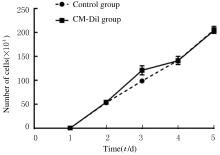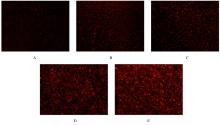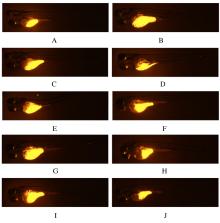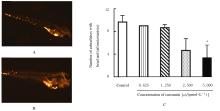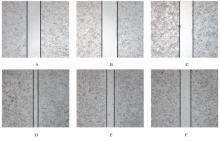Journal of Jilin University(Medicine Edition) ›› 2022, Vol. 48 ›› Issue (1): 9-17.doi: 10.13481/j.1671-587X.20220102
• Research in basic medicine • Previous Articles Next Articles
Establishment of zebrafish xenograft model of nasopharyngeal carcinoma and inhibitory effect of curcumin on CNE-2 cells
Zetai WANG1,Dandan LOU1,Yan PENG1,Daoqi ZHU1,Aiwu LI2,Fengying GONG2,Ying LYU2,Qin FAN1( )
)
- 1.Department of Molecular Biology,School of Traditional Chinese Medicine,Southern Medical University,Guangzhou 510515,China
2.Traditional Chinese Medicine,NanFang Hospital,Southern Medical University,Guangzhou 510515,China
-
Received:2021-06-04Online:2022-01-28Published:2022-01-17 -
Contact:Qin FAN E-mail:fqin@163.com
CLC Number:
- R285.5
Cite this article
Zetai WANG,Dandan LOU,Yan PENG,Daoqi ZHU,Aiwu LI,Fengying GONG,Ying LYU,Qin FAN. Establishment of zebrafish xenograft model of nasopharyngeal carcinoma and inhibitory effect of curcumin on CNE-2 cells[J].Journal of Jilin University(Medicine Edition), 2022, 48(1): 9-17.
share this article
| 1 | CHEN Y P, CHAN A T C, LE Q T,et al. Nasopharyngeal carcinoma[J].Lancet,2019,394(10192): 64-80. |
| 2 | SUN X S, LI X Y, CHEN Q Y, et al. Future of radiotherapy in nasopharyngeal carcinoma[J]. Br J Radiol, 2019, 92(1102): 20190209. |
| 3 | GIORDANO A, TOMMONARO G. Curcumin and cancer [J]. Nutrients,2019,11(10): 2376. |
| 4 | NELSON K M, DAHLIN J L, BISSON J, et al. The essential medicinal chemistry of curcumin[J]. J Med Chem, 2017, 60(5): 1620-1637. |
| 5 | KARI G, RODECK U, DICKER A P. Zebrafish: an emerging model system for human disease and drug discovery[J]. Clin Pharmacol Ther, 2007, 82(1): 70-80. |
| 6 | HORZMANN K A, FREEMAN J L. Making waves: new developments in toxicology with the zebrafish[J]. Toxicol Sci, 2018, 163(1): 5-12. |
| 7 | MACRAE C A, PETERSON R T. Zebrafish as tools for drug discovery[J]. Nat Rev Drug Discov, 2015, 14(10): 721-731. |
| 8 | BROWN H K, SCHIAVONE K, TAZZYMAN S, et al. Zebrafish xenograft models of cancer and metastasis for drug discovery[J]. Expert Opin Drug Discov, 2017, 12(4): 379-389. |
| 9 | CHEN X, LI Y, YAO T, et al. Benefits of zebrafish xenograft models in cancer research[J]. Front Cell Dev Biol, 2021, 9: 616551. |
| 10 | DEVEAU A P, BENTLEY V L, BERMAN J N. Using zebrafish models of leukemia to streamline drug screening and discovery[J]. Exp Hematol, 2017, 45: 1-9. |
| 11 | BOURNELE D, BEIS D. Zebrafish models of cardiovascular disease[J].Heart Fail Rev,2016,21(6): 803-813. |
| 12 | VÖLKEL P, DUPRET B, LE BOURHIS X, et al. The zebrafish model in oncology[J]. Med Sci (Paris), 2018, 34(4): 345-353. |
| 13 | 李振华, Alex Deepa, 徐燕玲, 等. 斑马鱼: 新型骨骼研究模式生物[J]. 中药药理与临床, 2010, 26(3): 67-71. |
| 14 | SETH A, STEMPLE D L, BARROSO I. The emerging use of zebrafish to model metabolic disease[J]. Dis Models Mech, 2013, 6(5): 1080-1088. |
| 15 | SULLIVAN C, MATTY M A, JURCZYSZAK D, et al. Infectious disease models in zebrafish[J]. Methods Cell Biol, 2017, 138: 101-136. |
| 16 | JAYASINGHE C D, JAYAWARDENA U A. Toxicity assessment of herbal medicine using zebrafish embryos: a systematic review[J]. Evid Based Complement Alternat Med, 2019, 2019: 7272808. |
| 17 | LI L, CHEN X, LIU C C, et al. Phytoestrogen bakuchiol exhibits in vitro and in vivo anti-breast cancer effects by inducing S phase arrest and apoptosis[J]. Front Pharmacol, 2016, 7: 128. |
| 18 | YANG D S, HE Q X, YANG Y P,et al. Chemical constituents of Euphorbia tibetica and their biological activities [J]. Chin J Nat Med,2014,12(1): 38-42. |
| 19 | GUO Y, FAN Y, PEI X. Fangjihuangqi Decoction inhibits MDA-MB-231 cell invasion in vitro and decreases tumor growth and metastasis in triple-negative breast cancer xenografts tumor zebrafish model[J]. Cancer Med, 2020, 9(7): 2564-2578. |
| 20 | ZHOU H, CAO H, ZHENG Y, et al. Liang-Ge-San, a classic traditional Chinese medicine formula, attenuates acute inflammation in zebrafish and RAW 264.7 cells[J].J Ethnopharmacol, 2020, 249: 112427. |
| 21 | GUT P, REISCHAUER S, STAINIER D Y R, et al. Little fish, big data: zebrafish as a model for cardiovascular and metabolic disease[J]. Physiol Rev, 2017, 97(3): 889-938. |
| 22 | ESPINO-SALDAÑA A E, RODRÍGUEZ-ORTIZ R, PEREIDA-JARAMILLO E, et al. Modeling neuronal diseases in zebrafish in the era of CRISPR[J]. Curr Neuropharmacol, 2020, 18(2): 136-152. |
| [1] | . Inhibitory effect of curcumin on tumor growth in colorectal cancer mice and its mechanism of PTEN/PI3K/Akt signaling pathwayPEI Yongbin, WANG Guiqi, LI Wei, JIANG Xia, JIANG Haibo, ZHAO Zengren (Department of General Surgery,First Hospital,Hebei Medical University, Shijiazhuang 050031,China) [J]. Journal of Jilin University(Medicine Edition), 2021, 47(1): 145-151. |
| [2] | Hongfang LI,Shao YANG,Mohan CAO,Lili YUAN,Xiaojin LI,Caixing SHI,Zhuoya WANG,Bailiu YA. Improvement effect of curcumin on cerebral microcirculation disorder in hypercholesterolemia model rats and its mechanism [J]. Journal of Jilin University(Medicine Edition), 2021, 47(1): 53-58. |
| [3] | LIU Luyao, ZHANG Wenwen, CAO Juan, LI Weibo, SUN Hongchen, LI Bo. Effect of curcumin on gene expressions of cytokines secreted by tumor-associated macrophages [J]. Journal of Jilin University(Medicine Edition), 2020, 46(05): 930-936. |
| [4] | ZHAO Liping, HUANG Shubing, ZHANG Boping, ZHOU Zhilan, JIA Xuebing, SUN Mengfei, QIAO Chenmeng, CHEN Xue, SHEN Yanqin, CUI Chun. Inhibitory effect of Lactobacillus rhamnosus on intestinal inflammation after spinal cord injury in zebrafishes and its mechanism [J]. Journal of Jilin University(Medicine Edition), 2020, 46(04): 680-686. |
| [5] | ZHOU Yabin, HUA Jin, QI Lingli, DAI Lu, PANG Xiaoli. Protective effect of curcumin pre-treatment on liver of acute ischemia-reperfusion model rats [J]. Journal of Jilin University(Medicine Edition), 2020, 46(02): 297-301. |
| [6] | ZHAO Miao, WANG Yi, ZHANG Ying, FENG Yumei, CAO Yawen, JIANG Haisen, LI Wei. Improvement effect of curcumin on cognitive function in mice with sleep deprivation and its mechanism [J]. Journal of Jilin University(Medicine Edition), 2019, 45(06): 1373-1378. |
| [7] | XU Dongliang, PENG Zhaohui, XIONG Meicai. Promotion effect of curcumin on implant osseointegration in osteoporosis rats [J]. Journal of Jilin University(Medicine Edition), 2019, 45(04): 877-881. |
| [8] | FENG Jingyuan, LI Shucheng, WANG Hong, HUANG Xiansheng, ZHANG Aiwen, WANG Wenfeng. Improvement effect of curcumin on Renin-angiotensin-aldosterone system and heart funotion in rats with chronic heart failure [J]. Journal of Jilin University(Medicine Edition), 2019, 45(02): 325-330. |
| [9] | WEI Jie, LI Kaiji, LUO Guangling, WEI Jingbo, LI Baowei, HE Hongwei, ZHEN Yongzhan. Protective effects of curcumin on hepatic injury of rats with experimental hepatic fibrosis [J]. Journal of Jilin University Medicine Edition, 2015, 41(02): 225-229. |
| [10] | ZHAO Zhao-hua,WU Shu-qiang,GOU Xing-chun,MI Ya-jing,YANG Ji-ping, SHI Li-li,CHENG Juan-juan. Influence of curcumin in NO and S100β levels in brain tissue of rats after focal cerebral ischemia reperfusion injury [J]. Journal of Jilin University Medicine Edition, 2014, 40(05): 925-928. |
| [11] | YU Song,HU Jiang-ping. Influence of curcumin in caspase-3,9 and livin expressions in brain tissue of iron load mice and its protective effect on nervous system [J]. Journal of Jilin University Medicine Edition, 2013, 39(5): 868-871. |
| [12] | . Protective effect of curcumin on kidney of rats with diabetic nephropathy and its mechanism [J]. Journal of Jilin University Medicine Edition, 2013, 39(4): 747-750. |
| [13] | YANG Ping,SUI Si-bo,WANG Yan-fang,YANG Jing,ZHANG Min,LI Xiao-kun,. Determination of curcumin and curcumin derivative A in rat plasma [J]. J4, 2012, 38(3): 598-602. |
| [14] | . Inhibitory |effects |of curcumin associatedwith CIK cells |on proliferation of |ovarian carcinoma cells and their mechanisms [J]. J4, 2011, 37(2): 220-225. |
| [15] | KANG Shun-ai,GUO Cai-xia,WANG Zhi-cheng,LI Yan-bo,YAO Chong-shun,GONG Shou-liang,LI Xiao-kun. Preventive effect of curcumin on UVB oxidation carcinogenesis in HaCaT cells [J]. J4, 2009, 35(2): 205-209. |
